广州新版七年级下册 U5
- 格式:ppt
- 大小:8.26 MB
- 文档页数:47

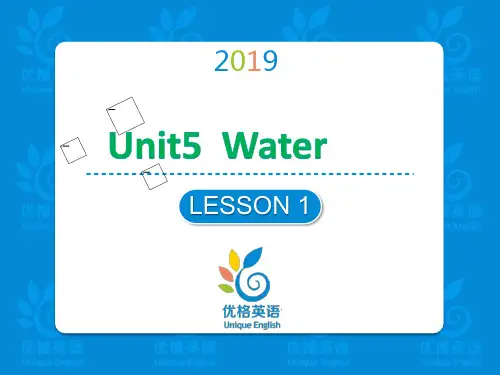
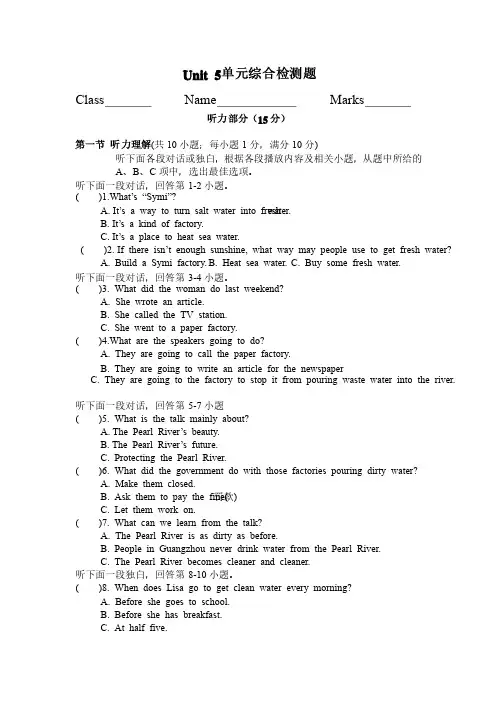
Class Name Marks Water is very( A ) to us. The use of water ( ( B B B ) ) food, food, wash wash wash clothes, clothes, clothes, take take take a a bath, make electricity and put out fires. Things we shouldn’t do Don’t pour( C ) water and ( D ) into rivers. If we use water better , we’ll live a happier and( E ) life. A. do B. doing C. to do D. did ( )2)20.He’s always very0.He’s always very ______when he talks about his travels. A. interest B. interests C. interesting D. interested 第二节第二节 语法选择(共10小题;每小题1分,满分10分) Timo was in charge of (负责) a case: s omeone kidnapped a millionaire’s son.someone kidnapped a millionaire’s son. The kidnapper__21__the millionaire to to prepare prepare $10 $10 million million and and __22__ __22__ __22__ it it it beside beside beside a a sculpture(雕像) ) in in in a a a park park park at at at 11 11 11 a.m. a.m. a.m. When When When it__23__close it__23__close it__23__close to to to 11 11 11 a.m., a.m., a.m., a a a young young young lady lady came and __24__the bag of money away. Timo and a group of police followed__25__.She took a taxi and got off at a train station. She put the bag__26__a locker and then ran to the train. The train left as soon as the woman got on. The police couldn’t follow follow her. her. her. They They They thought thought thought someone someone someone might might might come come come to to to take take take the the the bag, bag, bag, so so so they they waited beside the locker.__27__no one came. After half an hour, the police opened the locker. To their__28__,there was no money in the bag. ”Well, I __29__ I know who the real kidnapper is,” said Tiom.__30__ did Timo know the fact? said Tiom.__30__ did Timo know the fact? ( ) 21.A. asked B. ask C. asks D. to ask ( ) 22. A. puts B. put C. being put D. putting ( ) 23. A. gets B. was getting C. get D. is getting ( ) 24. A. took B. take C. takes D. taking ( ) 25. A. she B. hers C. her D. herself ( ) 26. A. at B. in C. on D. of ( ) 27. A. And B. So C. Or D. But ( ) 28. A. surprised B. surprising C. surprises D. surprise ( ) 29. A. think B. thought C. thinks D. to think ( ) 30. A. What B. If C. How D. Where 三、完形填空。
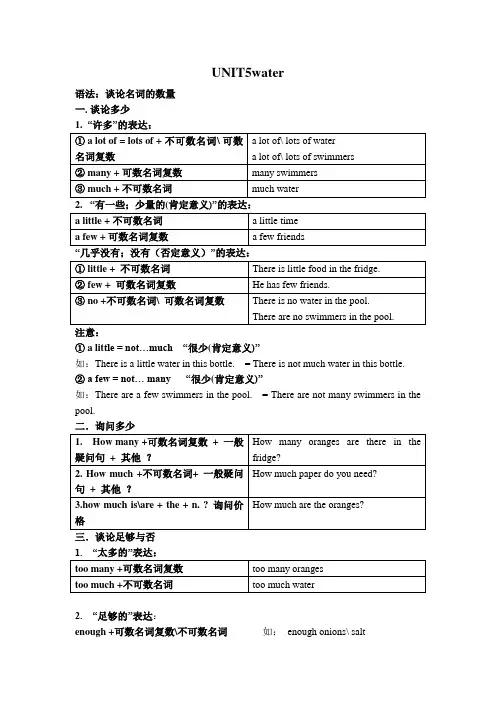
UNIT5water语法:谈论名词的数量一. 谈论多少2.“有一些;少量的(肯定意义)”的表达:注意:① a lit tle = not…much “很少(肯定意义)”如:There is a little water in this bottle. = There is not much water in this bottle.②a few = not… many “很少(肯定意义)”如:There are a few swimmers in the pool. = There are not many swimmers in the pool.二.询问多少三.谈论足够与否1. “太多的”表达:2. “足够的”表达:enough +可数名词复数\不可数名词如:enough onions\ salt3. “不足的”表达:not enough +可数名词复数\不可数名词如:not enough onions\ salt四.区别1. too much +不可数名词“太多的、、、”much too + adj.\ adv. “太、、、”如:The beef is much too delicious. 牛肉太好吃了。
五、分数的表达先分子,再分母,分子用基数,分母用序数,当分子为大于1的整数时,分母要变复数。
quarter 1/4 half 1/2 two thirds 2/3 three fifths 3/5UNIT6electricirt语法:情态动词一、情态动词的定义情态动词是一类用于表示说话人的感情和态度的助动词。
二、情态动词的特点1. 情态动词后面跟的动词需用原形,否定式构成是在情态动词后面加 "not"。
3. 个别情态动词有过去式, 过去式用来表达更客气, 委婉的语气, 时态性不强, 可用于过去,现在。
三、情态动词的用法【注意:】1) could 是can的过去式, 有两种用法, 一种表示过去式;一种用来表达更加客气, 委婉的语气, 时态性不强, 可用于过去,现在。
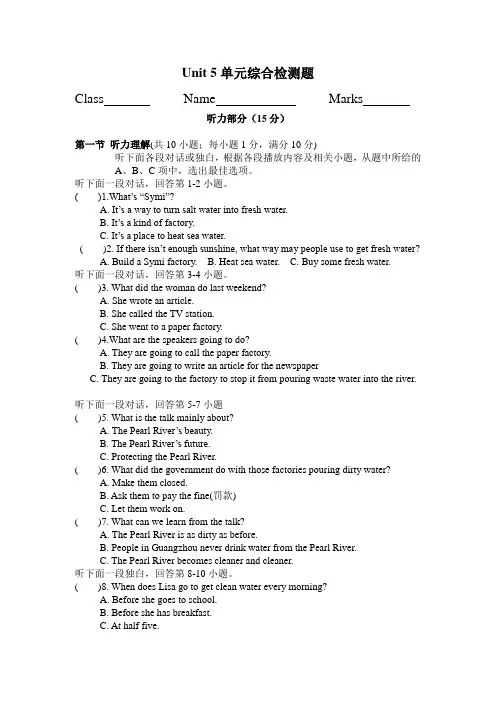
Unit 5单元综合检测题Class Name Marks听力部分(15分)第一节听力理解(共10小题;每小题1分,满分10分)听下面各段对话或独白,根据各段播放内容及相关小题,从题中所给的A、B、C项中,选出最佳选项。
听下面一段对话,回答第1-2小题。
( )1.What’s “Symi”?A. It’s a way to turn salt water into fresh water.B. It’s a kind of factory.C. It’s a place to heat sea water.( )2. If there isn’t enough sunshine, what way may people use to get fresh water?A. Build a Symi factory.B. Heat sea water.C. Buy some fresh water.听下面一段对话,回答第3-4小题。
( )3. What did the woman do last weekend?A. She wrote an article.B. She called the TV station.C. She went to a paper factory.( )4.What are the speakers going to do?A. They are going to call the paper factory.B. They are going to write an article for the newspaperC. They are going to the factory to stop it from pouring waste water into the river.听下面一段对话,回答第5-7小题( )5. What is the talk mainly about?A. The Pearl River’s beauty.B. The Pearl River’s future.C. Protecting the Pearl River.( )6. What did the government do with those factories pouring dirty water?A. Make them closed.B. Ask them to pay the fine(罚款)C. Let them work on.( )7. What can we learn from the talk?A. The Pearl River is as dirty as before.B. People in Guangzhou never drink water from the Pearl River.C. The Pearl River becomes cleaner and cleaner.听下面一段独白,回答第8-10小题。
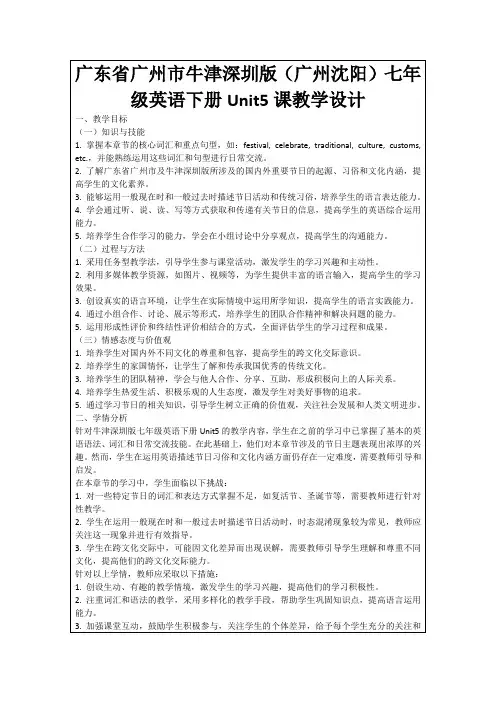
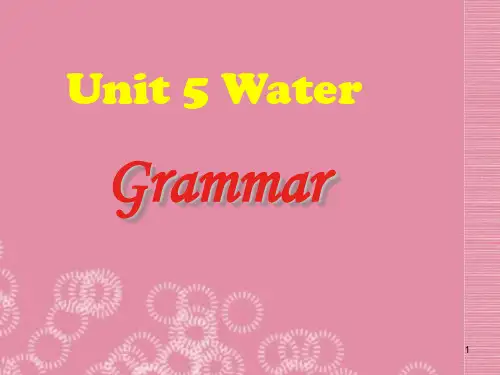
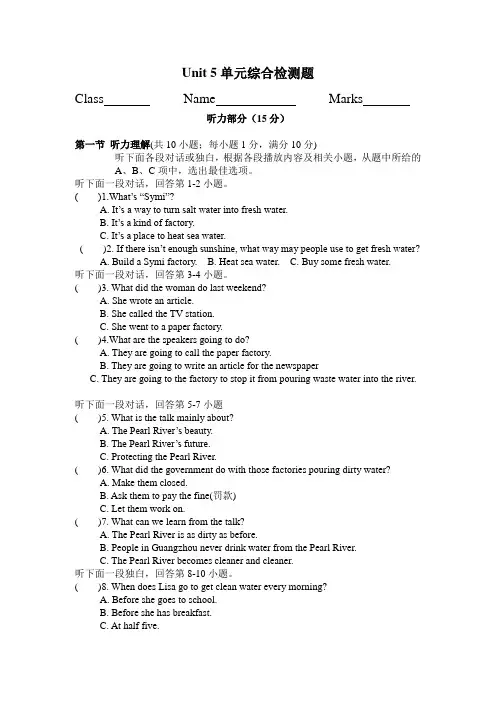
Unit 5单元综合检测题Class Name Marks听力部分(15分)第一节听力理解(共10小题;每小题1分,满分10分)听下面各段对话或独白,根据各段播放内容及相关小题,从题中所给的A、B、C项中,选出最佳选项。
听下面一段对话,回答第1-2小题。
( )1.What’s “Symi”?A. It’s a way to turn salt water into fresh water.B. It’s a kind of factory.C. It’s a place to heat sea water.( )2. If there isn’t enough sunshine, what way may people use to get fresh water?A. Build a Symi factory.B. Heat sea water.C. Buy some fresh water.听下面一段对话,回答第3-4小题。
( )3. What did the woman do last weekend?A. She wrote an article.B. She called the TV station.C. She went to a paper factory.( )4.What are the speakers going to do?A. They are going to call the paper factory.B. They are going to write an article for the newspaperC. They are going to the factory to stop it from pouring waste water into the river.听下面一段对话,回答第5-7小题( )5. What is the talk mainly about?A. The Pearl River’s beauty.B. The Pearl River’s future.C. Protecting the Pearl River.( )6. What did the government do with those factories pouring dirty water?A. Make them closed.B. Ask them to pay the fine(罚款)C. Let them work on.( )7. What can we learn from the talk?A. The Pearl River is as dirty as before.B. People in Guangzhou never drink water from the Pearl River.C. The Pearl River becomes cleaner and cleaner.听下面一段独白,回答第8-10小题。
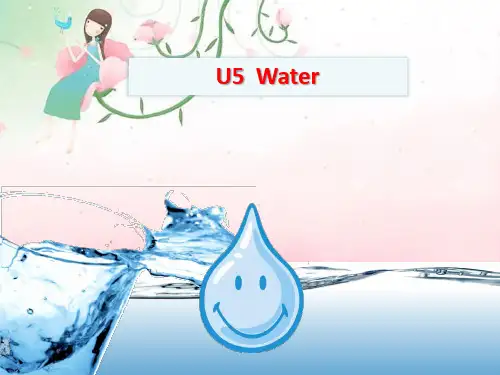
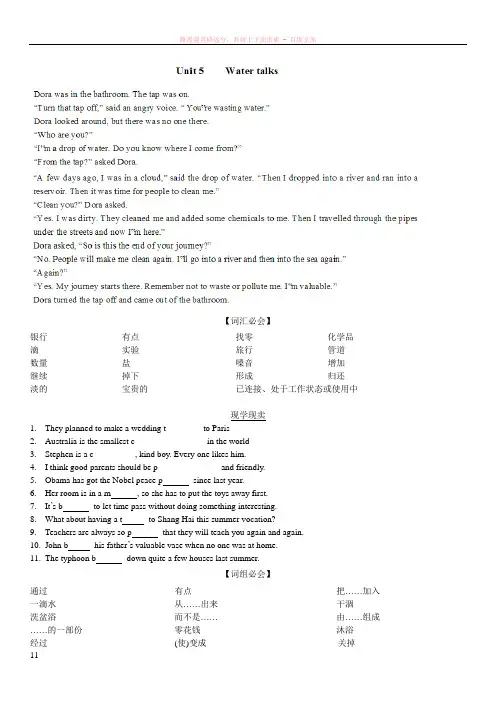
【词汇必会】银行___________ 有点___________ 找零___________化学品___________滴___________ 实验___________旅行___________管道___________数量___________ 盐___________ 嗓音___________增加___________继续___________ 掉下___________ 形成___________ 归还___________淡的___________ 宝贵的___________已连接、处于工作状态或使用中___________现学现卖1.They planned to make a wedding t________ to Paris2.Australia is the smallest c________________ in the world3.Stephen is a c_________ , kind boy. Every one likes him.4.I think good parents should be p______________ and friendly.5.Obama has got the Nobel peace p since last year.6.Her room is in a m , so she has to put the toys away first.7.It’s b to let time pass without doing something interesting.8.What about having a t to Shang Hai this summer vocation?9.Teachers are always so p that they will teach you again and again.10.John b his father’s valuable vase when no one was at home.11.The typhoon b down quite a few houses last summer.【词组必会】通过_________________有点_________________把……加入_________________一滴水_________________从……出来_________________干涸_________________洗盆浴_________________而不是……_________________由……组成_________________……的一部份_________________零花钱_________________沐浴_________________经过_________________(使)变成_______________________关掉_________________现学现卖1.并非所有的水都是可喝的。
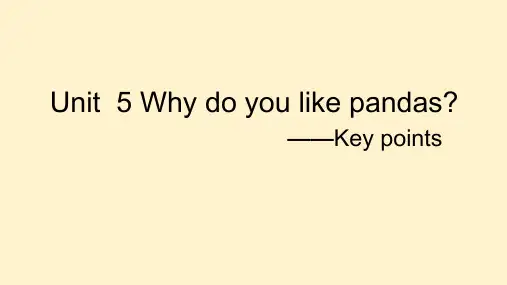
一、选择题1.— do you like penguins? — Because are very interesting.A.Why , you B.What, they C.What, you D.Why, they D解析:D【解析】句意:——你为什么喜欢企鹅?——因为它们很有趣。
考查疑问词和代词辨析题。
why问原因,what问事/物,根据答语because可知问的是原因,可排除BC选项。
问句中penguins(企鹅)是物,回答需用they代替,故选D。
2.—Sir, Jenny wants to know when she can leave the office.—Only when she ______ copying this report.A.finishes B.finishC.finished D.will finish A解析:A【解析】试题分析:句意:--先生,珍妮想知道她能什么时间离开办公室。
--只有当她抄完这份报告的时候才能离开。
when引导时间状语从句时,如果主从句动作都没有发生,主句动作用将来时,从句用一般现在时。
根据主语是第三人称单数,所以谓语动词用相应的第三人称单数,故选A。
【考点定位】考查时间状语从句的用法。
3.—Where ________ the singer Liu Dacheng ________?—Shandong.A.do;come from B.does;fromC.is;from D.is;come from C解析:C【解析】句意:——歌手刘大成是哪里人?——山东。
be from或come from都表示“来自……”。
问句中主语为第三人称单数,先排除A;B选项缺少实义动词;D选项中be动词与实义动词不能同时使用,故答案选C。
4.This is elephant and elephant is from Africa.A.a;the B.an;theC.an;an D.the;an B解析:B【解析】句意:这是一头大象,这大象来自非洲。
⼴州市七年级下册英语U5语法专练七年级下册英语U5 语法专练姓名____________________⼀、疑问代词who 和whosewho与whose都是疑问代词,⼀般放在句⾸,⽤来构成特殊疑问句。
1、who的意思是“谁”,在句⼦中做主语,相当于名词、⼈称代词主格。
后⾯不加名词。
如:—Who is he ?—He is John .他是谁?他是约翰。
—Who teaches your English?—Miss Liu.谁教你英语?刘⽼师。
当⽤who提问,不知道是谁和⼈的数量时,问句的谓语动词常⽤单数。
如:Who isn't at school today?今天谁没到校?2、whose的意思是“谁的”,可以单独使⽤,也可以和名词⼀起⽤,充当表语,定语等,相当于形容词。
1)提问部分作定语时,⽤“Whose +名词+⼀般疑问句?”结构。
如:Whose shirt is it?→It's my shirt.这是谁的衬衫?→这是我的衬衫。
2)提问部分作表语时,⽤“Whose +⼀般疑问句?”结构。
如:Whose is the shirt?→The shirt is mine.这件衬衫是谁的?→这件衬衫是我的。
单项选择1、_______ is the boy talking with your mother? He is Bob.A. WhoB. WhoseC. WhichD. What2、_______is the MP4 on my desk?A. WhoB. WhoseC. WhichD. What3、_______friend is Lo? Tom’s.A. WhoseB. WhoC. WhatD. When4、_______ is Lo’s mother? Mrs. Smith.A. WhoseB. WhoC. WhatD. When5、_______is Tom? He’s David’s father.A. WhoB. WhoseC. WhichD. What6、_______ daughter is Ann? She is Kelly’s daughter.A. WhoB. WhoseC. WhichD. What⼆、物主代词1、概述表⽰所有关系的代词叫做物主代词(Possessive Pronouns),也叫⼈称代词的所有格。
Unit 5 Poems about life一、Teacher introduction:Wei Yan(魏燕),teaching in Class 1 & 2, Grade 1,Guangzhou Nan WuExperimental School二、Textbook Edition:Oxford English shanghai Edition三、Teaching Topic:七年级第二学期A册,Unit 5 Poems about life --- Listening四、Teaching Period:1 Period(40 minutes)五、Analysis of the Textbook:a)The topic of the unit is “Poems about life”. The unit is different from teachingstudentslanguage knowledge or skills, but focuses on building up the abilities of appreciation and prehension of poems, the ways of reading a poem, and the features of a poem. The lesson is based on reading lessons and focuses on the way of reading.Also, it makes students feel the real emotion from their hearts and is the practice of writing.b)The students from Class 1 and 2 lively and many of them have a passion for speakingand playing. Some of them like writing very much. Encouraging them to practice and create poems is a task. In addition, helping more students to read fluently and emotionally is necessary.c)More students will be able to enjoy and learn some abilities of poems by studyingthe unit.六、 Teaching aim:1. Knowledge aim:Learn to read a poem with rhythm and emotion. Find the rhymes of the poem A on P69.2. Ability aim:a)Find out the mistakes and write the correct words while listening.b)Match the pictures and poems while listening.3. Strategies aim:Bring up the students to express their own feelings of lives through reading and writing poems.4. Feeling and attitudes aims:a. Let the students take part in the activities positively and cooperate in a group and learn from each other.b. According to reading practise, improve the students’ municating and writing ability.5. Culture aim:Understand western culture by studying English poems.七、 Teaching difficult points and important points:1. Teaching important points:a) Read the poems in the text and understand the features of them.b) Listen to the rhythm of the poems (Listening A). Understand the feelings from the poems (Listening B).c) Try to use the poems to express the feelings.2. Teaching difficult points:a) Understand the feelings from the poems (Listening B).b) Try to use the poems to express the feelings.八、Teaching Method:a) The municative method.b) Task-based approachc) Group work九、Teaching aids:puter, blackboard, note cards, handout.十、Teaching procedure:。